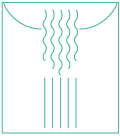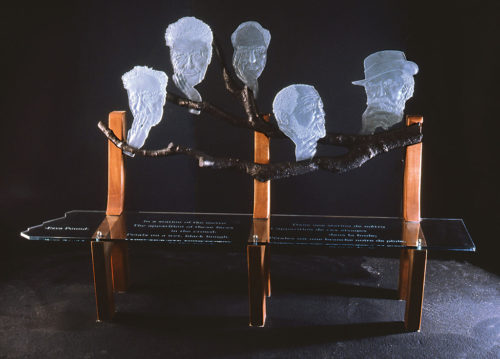Since I left college in the mid 1960’s I have had the good fortune to pursue a life that has been what I only could have dreamed in my youth. The shapers of my destiny have been a combination of people and events that have at the precise magical moment nudged me in the right direction.
My father, Max Linn gave me my first lessons in wood working and the pleasures of hand crafting when we made small step stools and World War II model airplanes from scratch. It was my loss and gain that his death, when I was 13, laid the groundwork for my independence and the ability to take the constant risks necessary to become an artist. This void, difficult for an adolescent, after a period of rebellion and uncertainty gave me the opportunity to look at every option and become what I wanted.
When I was young my imagination was fueled by biographies and radio dramas however my immersion in the arts began as an aside to my education in agriculture at the University of Illinois. My majoring in Floriculture and Ornamental Horticulture was as a result of the only scholarship I could claim at the end of my high school studies. In order to have a social life I got involved in musical theater production since the agriculture program was almost entirely masculine at that time. That led me to scenic design thanks to the opportunities presented to me by Ned Levy and Norvid Roos. At the same time because of the access offered me by my housemates who were all art students I was able to use the sculpture studios during off hours to recommence the making of personal objects.
After college I was fortunate to obtain a Ford Foundation/Arena Stage Internship to become an assistant designer at Arena Stage in Washington, D.C. and fall under the guiding hand of Robin Wagner. Robin, besides being an amazing artist that led him to be the recipient of several Tony Awards as Broadway’s best scenic designer, was also a keen observer of human behavior that helped him to be so successful. After a year working with him, he advised me that my non-compromising personality when it came to aesthetic decisions was not truly suited to the “team sport” of theater and I was much better off and happier when I was working on my sculpture. This was surely one of those eureka moments in one’s life and gave me the necessary push in the right direction.
From then on, I focused my life on becoming an artist, improving my drawing skills and taking jobs that would give me access to the tools and materials I would need to make my pieces. My early work was figurative, made exclusively out of wood although I did experiment with other materials such as welded steel, and stone. For the most part I found that these other materials lacked warmth and thus were not suited to the subjects of my sculptures.
In the late 1960’s I had a one-year appointment at Smith College teaching theater design as a replacement for a regular faculty member who was on sabbatical leave. During this time, I met Mike Brenneman who was running the foundry program at the University of Massachusetts in Amherst. He gave me the opportunity to try some bronze casting and I found that the bronze because of the detail that could be incised in the wax original gave me an added dimension that when combined with the wood enhanced my pieces which by now had become much more narrative.
For the next fifteen years I continued to work in this combination of materials while pursuing many different job opportunities that supplemented my income as a sculptor including the opportunity to run the foundry and be the technical instructor in sculpture at the University of California at Santa Cruz. In 1972 I was able to make a connection with Louis Meisel who exhibited my work in his SoHo, New York gallery. This gave my career the boost that every artist dreams of and in 1973 I moved to New York. Two years later with the encouragement of Jack Zajac, I won the Rome Prize in Sculpture and off I went to Italy for 1975 and 1976. This was my first experience in Europe and unbeknownst to me at the time sowed the seeds of my future desire to return to Europe to live.
In 1982 I got an idea to do a sculpture about Imogen Cunningham, a California photographer associated with the f64 group of Ansel Adams, Minor White, and Edward Weston. She used an 8 X 10 view camera for many of her images that utilizes treated glass plates for its negatives. I thought it would make a powerful statement to put her image, life sized, on a plate of glass along with other cast bronze elements to complete the sculpture. A restaurant window in mid-town Manhattan got me to sandblasting as a way to do this and the yellow pages by chance got me to Sam Shefts, one of the premier glass carvers, who taught me the technique that made it possible to execute the sculpture and begin the adventure with the third material which since 1983 has made up my repertoire.
Not long after incorporating glass into my work and while still exhibiting at the Meisel Gallery I met Ferd Hampson of the Habatat Gallery in Michigan. His gallery dealt almost exclusively in art that was made of glass. He was willing to accept my multimedia sculptures that incorporated the material but were not about the material and bring them to a new audience.
In 1993, my family and I left New York and moved to the south of France where I have been afforded the beauty of the countryside and the tranquility of village life to continue to produce my work and have the opportunity for European culture to seep into my bones and hopefully add to the many influences presented to this Chicago boy.
Throughout my career I have been a storyteller, a documentary sculptor, who takes these rigid materials and shapes them into supple histories of the lives of interesting people who have done marvelous things. I believe that my pieces should communicate on many levels and be accessible to all who view them. Therefore, they should have an initial impact of aesthetic appreciation, i.e., sculpture, where the forms are pleasing and the interaction of these forms and space tantalize the eye. From there, one can get into the storyline of the subject on the various levels presented, even to the point where the viewer wants to know even more details than I have presented and chooses to investigate further details of the subject’s life. In the past ten years I have also chosen to write a text that accompanies each piece in order to make evident the significance of many of the details that exist in the sculptures and assist the viewer with the understanding of what I was trying to accomplish.
Lastly, I would surely be remiss if I did not acknowledge the tremendous impact my wife, partner, and best critic, Karen Lehrer had on my career these past thirty plus years and who along with our daughter Katie have made me complete.


